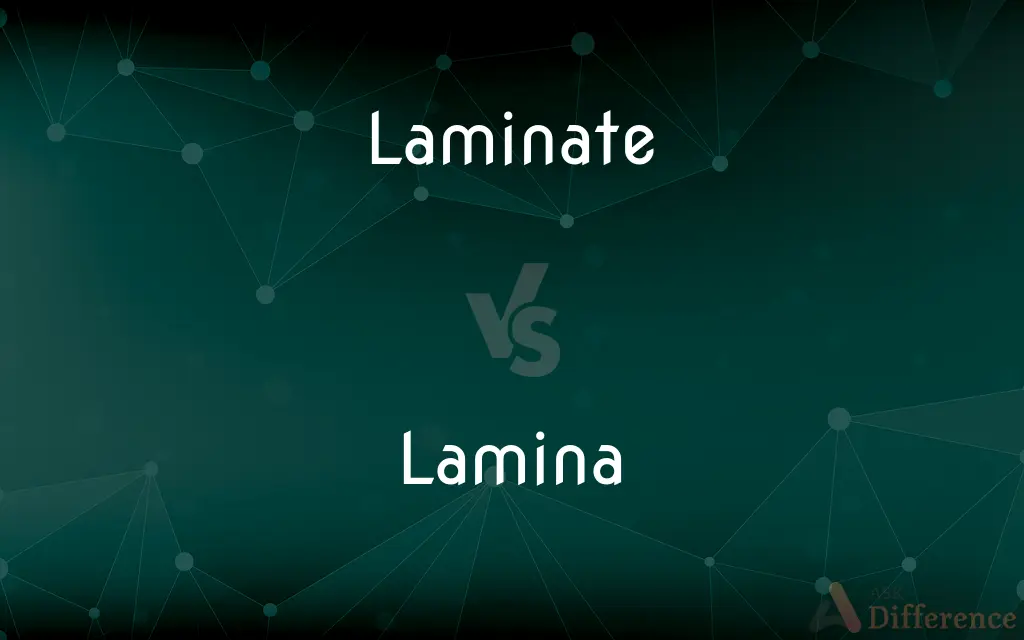Laminate vs. Lamina — What's the Difference?
By Tayyaba Rehman & Fiza Rafique — Updated on March 26, 2024
Laminate is a layered composite material, often used for surfaces, made by bonding layers together; lamina refers to a single layer or sheet, especially one of many in a stack or assembly.

Difference Between Laminate and Lamina
Table of Contents
ADVERTISEMENT
Key Differences
Laminate is created by bonding two or more layers of material together to enhance strength, durability, or appearance. These materials can include plastic, wood, or metal, used in flooring, countertops, and furniture. Whereas lamina signifies a single, often thin layer that can be part of natural or man-made structures, such as leaves, sheets of material, or the layers within a laminate.
Laminates are engineered for specific purposes, allowing customization in texture, color, and resistance to wear and tear. This makes them versatile in construction and manufacturing, adaptable to various needs. On the other hand, a lamina's properties are determined by its material composition and it serves as a fundamental unit within a larger structure, highlighting the importance of individual layers in composite materials.
The production process of laminate involves applying pressure and heat to bond the layers, often with adhesives or resin, creating a unified material with enhanced properties. Conversely, a lamina does not undergo a manufacturing process as a single entity but is instead prepared or sourced as a basic material, like wood veneer or metal sheet, to be used in further processes or as part of a composite.
Durability and application of laminate are key features, as it is designed to withstand environmental and mechanical stress, making it ideal for high-traffic areas. Lamina, while essential to the structure and functionality of laminates and other composites, depends on its integration into a larger system for its utility and strength.
In the context of use, laminate is chosen for its ability to mimic the appearance of other materials, such as hardwood or stone, at a lower cost and with increased durability. In contrast, a lamina might be selected for its specific characteristics, such as flexibility, transparency, or conductivity, contributing to the performance of the composite or structure it is part of.
ADVERTISEMENT
Comparison Chart
Definition
A composite material made by bonding layers
A single layer or sheet
Composition
Multiple layers of various materials
Single material
Purpose
Enhance strength, durability, appearance
Serve as a component in structures
Manufacturing
Bonding under heat and pressure
Prepared as is for use in composites
Application
Flooring, countertops, furniture
Part of laminates, biological structures
Compare with Definitions
Laminate
The process of creating a composite material in layers.
The laminate flooring was created by pressing together layers of wood and adhesive.
Lamina
A thin layer, plate, or sheet of material.
The lamina of the leaf is where most of the photosynthesis occurs.
Laminate
A type of flooring made from pressed wood.
They chose laminate for the living room because it was less expensive than hardwood.
Lamina
Any thin, flat layer or membrane.
Surgeons must be careful not to damage the delicate lamina during the operation.
Laminate
A product made by bonding together two or more layers of material.
The kitchen countertop was made of a durable laminate that resembled granite.
Lamina
The blade of a leaf, distinct from the petiole.
The plant's lamina was wide and flat, maximizing sunlight absorption.
Laminate
To produce a multiple-layer structure through bonding or assembly.
The artist laminated various types of paper to create a textured collage.
Lamina
A part of the vertebrate neural arch.
The lamina of the vertebra protects the spinal cord from damage.
Laminate
To cover a surface with a protective or decorative layer of laminate.
We decided to laminate the school maps to prevent them from tearing.
Lamina
A layer within a composite material or structure.
The carbon fiber component was reinforced with several laminae for extra strength.
Laminate
To cover with a thin sheet of material, as for preservation.
Lamina
A thin plate, sheet, or layer.
Laminate
To beat or compress (metal) into a thin plate or sheet.
Lamina
The expanded area of a leaf or petal; a blade.
Laminate
To divide into thin layers.
Lamina
The bladelike part of a kelp.
Laminate
To make by uniting several layers.
Lamina
A thin layer of bone, membrane, or other tissue.
Laminate
To split into thin layers or sheets.
Lamina
(Zoology) A thin scalelike or platelike structure, as one of the thin layers of sensitive vascular tissue in the hoof of a horse.
Laminate
Consisting of, arranged in, or covered with laminae.
Lamina
(Cytology) A thin layer inside the nuclear membrane of a cell that is composed of a meshlike network of protein fibers.
Laminate
A laminated product, such as plywood.
Lamina
(Geology) A narrow bed of rock.
Laminate
A thin sheet of material, or the material itself, such as plastic, used to laminate something.
Lamina
A thin layer, plate, or scale of material
Laminate
To assemble from thin sheets glued together.
Lamina
(skeleton) either of two broad, flat plates of bone of a vertebra that is fused with and extends from the pedicle to the median line of the neural arch to form the base of the spinous process and that along with the pedicle forms the posterior part of the vertebral foramen
Laminate
To cover something flat, usually paper, in adhesive protective plastic.
We laminated the printouts so we could use them as signage.
Lamina
(botany) the flat expanded part of a foliage leaf or leaflet
Laminate
To form, as metal, into a thin plate, as by rolling.
Lamina
(geology) a fine layer that occurs in sedimentary rocks
Laminate
To cause to separate into thin plates or layers; to divide into thin plates.
Lamina
(zootomy) one of the narrow thin parallel plates of soft vascular sensitive tissue that cover the flesh within the wall of a hoof
Laminate
Material formed of thin sheets glued together.
Lamina
A thin plate or scale; a layer or coat lying over another; - said of thin plates or platelike substances, as of bone or minerals.
Laminate
Consisting of, or covered with, laminae, or thin plates, scales, or layers, one over another; laminated.
Lamina
The blade of a leaf; the broad, expanded portion of a petal or sepal of a flower.
Laminate
Consisting of, or covered with, laminæ, or thin plates, scales, or layers, one over another; laminated.
Lamina
A thin plate or scale; specif., one of the thin, flat processes composing the vane of a feather.
Laminate
To cause to separate into thin plates or layers; to divide into thin plates.
Lamina
A thin plate or layer (especially of bone or mineral)
Laminate
To form, as metal, into a thin plate, as by rolling.
Laminate
To form by uniting two or more layers (in sheet form) of a material, so that the layers are bonded tightly.
Laminate
To unite (layers in sheet form) by bonding, so as to create a single object with multiple layers; - used with the material in sheet form as the object; as, to laminate plywood.
Laminate
To separate into laminæ.
Laminate
A sheet of material made by bonding two or more sheets or layers
Laminate
Create laminate by putting together several thin sheets of a material
Laminate
Press or beat (metals) into thin sheets
Laminate
Cover with a thin sheet;
Laminate the table
Laminate
Split (wood) into thin sheets
Common Curiosities
Where is laminate commonly used?
Commonly used in flooring, countertops, and furniture for its durability and versatility.
What is a common use of a lamina?
Common uses include components in laminates and biological structures like leaves.
What are the benefits of using laminate?
Benefits include lower cost, increased durability, and versatility in appearance.
How is lamina used in manufacturing?
It serves as a basic material for composites or as part of a larger assembly.
What does lamina refer to?
Lamina refers to a single, thin layer or sheet, which can be part of natural or man-made structures.
What is laminate made of?
Laminate is made of multiple layers of materials bonded together, often including plastic, wood, and metal.
How is laminate produced?
It is produced by bonding layers under heat and pressure, often using adhesives or resin.
How does a lamina differ from laminate?
A lamina is a single layer, while laminate is composed of multiple bonded layers.
Do all laminates look the same?
No, laminates can vary widely in texture, color, and pattern, depending on their intended use.
How do you care for laminate surfaces?
Care involves regular cleaning with non-abrasive materials and avoiding prolonged exposure to moisture.
Can laminate mimic other materials?
Yes, laminate can mimic the appearance of hardwood, stone, and other materials.
Is laminate waterproof?
Some laminates are designed to be water-resistant, but not all are completely waterproof.
Can laminates be recycled?
Recycling laminates can be challenging due to their mixed material composition, but it is possible with certain types.
What is the main advantage of a lamina in composites?
Its specific characteristics, such as flexibility or conductivity, contribute to the composite's performance.
Is every lamina part of a laminate?
Not necessarily; while laminae can be components of laminates, they also exist independently in various applications.
Share Your Discovery

Previous Comparison
Desire vs. Drive
Next Comparison
Among vs. BetweenAuthor Spotlight
Written by
Tayyaba RehmanTayyaba Rehman is a distinguished writer, currently serving as a primary contributor to askdifference.com. As a researcher in semantics and etymology, Tayyaba's passion for the complexity of languages and their distinctions has found a perfect home on the platform. Tayyaba delves into the intricacies of language, distinguishing between commonly confused words and phrases, thereby providing clarity for readers worldwide.
Co-written by
Fiza RafiqueFiza Rafique is a skilled content writer at AskDifference.com, where she meticulously refines and enhances written pieces. Drawing from her vast editorial expertise, Fiza ensures clarity, accuracy, and precision in every article. Passionate about language, she continually seeks to elevate the quality of content for readers worldwide.












































